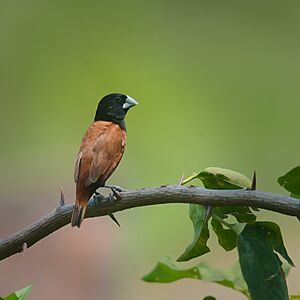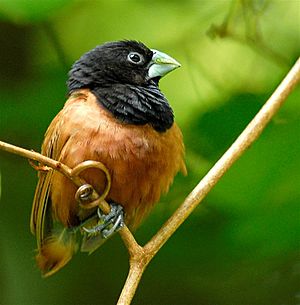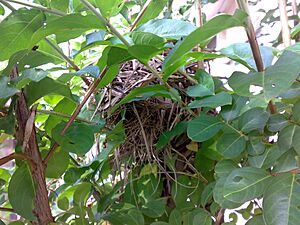Chestnut munia facts for kids
Quick facts for kids Chestnut munia |
|
|---|---|
 |
|
| Lonchura atricapilla jagori in Cebu, Philippines | |
| Conservation status | |
| Scientific classification | |
| Genus: |
Lonchura
|
| Species: |
atricapilla
|
 |
|
| range | |
The chestnut munia (Lonchura atricapilla), also called the black-headed munia, is a small passerine bird. This means it's a type of small perching bird. It's a kind of estrildid finch, which is a family of small seed-eating birds.
You can find these birds living in many countries across Asia. This includes places like India, China, Indonesia, the Philippines, and Vietnam. They have also been brought to Hawaii and some islands in the Caribbean.
Before 1995, the chestnut munia was the national bird of the Philippines. People there called it mayang pula, which means "red maya." This name comes from a special brick-red patch on its lower back. You can only see this red patch when the bird flies! This helps tell it apart from other birds called "maya," like the "mayang simbahan" (tree sparrow), which is more common in cities.
What Does It Look Like?
The chestnut munia is a small bird, usually about 11 to 12 centimeters long. That's about the length of your hand! Both male and female birds look very similar.
Adult birds have a shiny black head and a brown body. Their lower back has a bright brick-red patch that shows when they fly. Some types of chestnut munias also have a black belly. They have a short, pale gray-blue beak, chestnut-colored eyes, and gray legs.
Young chestnut munias look a bit different. Their upper parts are a plain pale brown. They don't have the dark head like the adults. Their undersides are white or light cream.
Where Do They Live?
Chestnut munias are social birds that like to live in groups. They mostly eat grains and other seeds. You can often find them in open grasslands and farm areas.
These birds build their nests in bushes or tall grass. Their nests are large and shaped like a dome, made from grass. Inside, the female bird lays about 4 to 7 white eggs.
National Bird of the Philippines
The black-headed munia was once the national bird of the Philippines. This was true until 1995. After that, the Philippine eagle became the national bird.
In the Philippines, people sometimes confuse the chestnut munia with the Eurasian tree sparrow. This is because cities have grown, and people see the tree sparrow more often in urban areas. Both birds are sometimes called "maya" in the Philippines.





